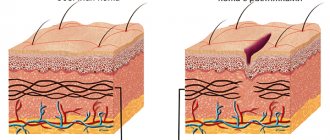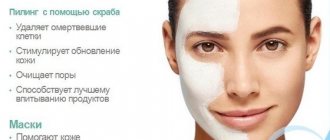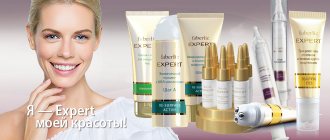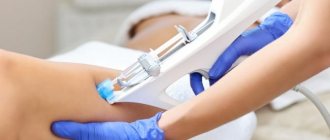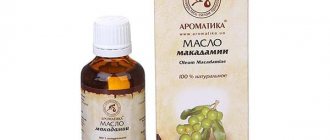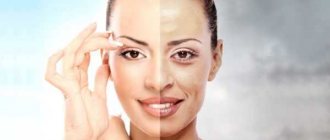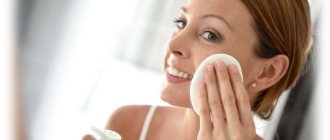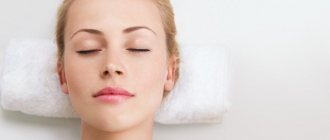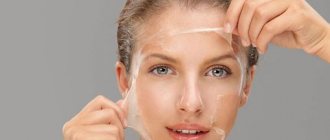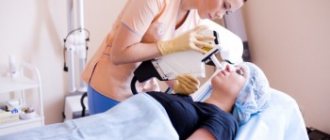We all dream of having smooth and beautiful skin, but the presence of scars (scars) on it can cause a lot of problems for both men and women. The causes of these defects can be various factors: diseases, burns, surgical interventions or injuries. If, during the healing of the injury, epithelization is disrupted ,
then scar tissue is formed, which is better to get rid of with the help of peelings. And the younger the scar, the greater the chance of removing them completely.
There are many types of peeling, which differ mainly only in the principle of action, but lead to the same result. But at the moment there are two most effective and popular options - dermabrasion and chemical peeling. Which one is the best peeling for scars can be determined by your attending physician, based on the characteristics of the skin, existing diseases and the characteristics of the scars. Well, for now let’s get to know them better.
Peeling for acne scars: types, photos, reviews and tips for choosing
Acne scar peeling can get rid of these serious blemishes. Such procedures remove the upper layers of the epidermis, while destroying scar tissue.
Glycolic peeling
This type of exfoliation is based on glycolic acid, which can cleanse sebaceous ducts and rejuvenate the skin. Glycolic peeling is perfect for women over 30 who experience periodic rashes and post-acne.
This procedure is superficial. It is carried out using a solution with a concentration of up to 25%. It is prescribed for problematic and oily dermis with single pimples.
There is also a medium glycolic peel, which is used for serious structural changes and the presence of severe acne.
Exfoliation is carried out strictly according to a specific scheme. This takes from 20 minutes to half an hour. The procedure is performed only in winter and autumn.
Deep phenolic peeling
This procedure is painful and invasive. Phenol has an effect on the surface of the skin and also penetrates into its deeper layers. The skin is destroyed almost down to the subcutaneous fatty tissue.
One procedure is enough to visually hide the presence of scars. The duration of the recovery period is 14 days. This method allows you to get rid of deep keloid scars.
The downside is pain and increased skin pigmentation during the rehabilitation period.
Peeling 35-50% trichloroacetic acid (TCA)
For medium or deep cleansing of the dermis using trichloroacetic acid, glycolate is added to the composition. The product obtained in this way will help soften the scar tissue. As a result, in 3-5 procedures it will completely peel off. Repeated sessions should be done infrequently, once a month is enough, since TCA peeling traumatizes the skin.
Laser peeling
Laser peeling for acne scars shows positive results after the first session. However, it should be noted that this procedure is quite painful. Before carrying out it, you need to familiarize yourself with the existing contraindications.
Laser peeling is carried out using erbium or carbon dioxide lasers. This exfoliation is cold, in which cells in the upper layers are removed, while the lower ones are not affected. There is also a hot one.
It belongs to the deep type because it penetrates into the lower layers of the epidermis. As a result of laser resurfacing:
- collagen is produced;
- skin turgor improves;
- the face acquires a healthy tone.
Coral
This procedure gently removes the top layer of the epidermis and smoothes out scars. To perform coral peeling, special preparations are used, which contain:
- crushed sea corals;
- vegetable oils;
- herbal extracts.
Most often, this procedure is prescribed for those who are contraindicated for chemical peeling, as well as people with sensitive dermis. It is prohibited to do it when:
- rosacea;
- herpes;
- demodicosis.
Microcrystalline dermabrasion
This procedure is a modern method of mechanical peeling. It is performed using microcrystals of diamond or aluminum and under the influence of vacuum. The latter is created by a special apparatus. The dermabrasion method is very painful, so application anesthesia is required before the procedure. Microcrystals can remove:
- wrinkles;
- post-acne;
- various spots;
- very deep scars.
Microcrystalline peeling for acne scars cannot be done on thin and sensitive dermis, people with blood and heart pathologies, or herpes.
After the procedure, you must ensure that the skin is not exposed to sunlight for 2-3 days; it is also prohibited to use scrubs.
This cleansing method refers to deep peeling, so you need to prepare first, and then there will be a long rehabilitation.
Contraindications and side effects
In order to achieve a noticeable visual effect, it is necessary to carry out a facial peeling procedure for acne scars in 2-3 stages with an interval of 1 to 3 months, this depends on the restoration of the skin. As for the thin and sensitive dermis, peelings are dangerous for it; the action of acids negatively affects its condition.
The first step is to perform a test. Be sure to check for allergic reactions before the procedure. All peels, including the most gentle one, have a number of contraindications that you need to familiarize yourself with. These procedures are complex, lengthy, stressful, and many of them are quite painful for the body.
They are not recommended if the dermis is prone to forming keloid scars.
Reviews
According to numerous reviews, peeling for acne scars also helps get rid of age spots. Women like its gentle appearance; under the gentle influence of glycolic acid, the skin is renewed and acquires a healthy appearance. This procedure prevents the appearance of various rashes and is an excellent preventative against acne.
Laser peeling helped some people cope with the problem. Although this procedure is not cheap, the result is amazing and very lasting. Even after a year, the skin on the face remains clean and smooth, as well as:
- foci of inflammation disappear;
- normal complexion is restored;
- the relief of the dermis is leveled.
Recommendations from cosmetologists
Your doctor can advise you on the best peeling for acne scars. Laser and physical peeling are only effective for removing scars, not:
- old;
- strongly expressed;
- deep.
A more radical method, which is chemical, is used to eliminate very noticeable, deep and long-standing scars. However, experienced cosmetologists agree that it is always necessary to start with gentle treatment methods.
All types of peelings, in addition to eliminating scars, improve the quality of the dermis, enhance its protective properties, remove fine wrinkles, age spots, and renew the skin. To remove acne, it is recommended to go to a beauty salon. Properly selected exfoliation will help reduce dermal imperfections in several sessions.
Before choosing a specific procedure, it is recommended to look at photos of peeling for acne scars and study the reviews well.
Chernaya Natalya
Are there any contraindications and side effects?
Achieving a visually noticeable cosmetic effect requires a procedure in two/three stages. Moreover, the interval between these stages should be from 1 to 3 months (depending on how the skin regeneration proceeds). It is dangerous to use peelings for sensitive and thin skin.
Under the influence of acids, her condition can be made even worse. First you need to carefully and accurately do a small test. Checking for allergic reactions before performing a scar removal procedure is also desirable, and even mandatory.
All this needs to be clarified before exposing the skin to highly concentrated formulations.
All peels, from the most gentle to the most radical, have a number of contraindications.
Peels for scars: contraindications
Any peeling is a protracted procedure, quite complex, painful and stressful for the body. You should not decide on it when the skin clearly has a tendency to form keloid scars. There is also a certain list of contraindications related to the general condition of the body.
This
- pregnancy and breastfeeding months;
- the presence of benign or malignant tumors;
- heart and vascular diseases, as well as hypertension;
- liver and kidney diseases;
- endocrine disorders and diabetes;
- manifestations of rosacea and rosacea;
- mental illnesses and disorders;
- allergic manifestations to the components of peeling compositions.
Results
If you intend to do facial peeling, then you need to understand that the “removal” of scars should still be done by an experienced cosmetologist. There is too high a chance that you will only worsen the condition of your skin if you do this serious procedure yourself, at home.
Moreover: the choice of a specialist, as well as the correction method, also needs to be approached responsibly: do not leave your appearance in the hands of the “first” doctor you come across, but attend at least three consultations in different places, collect information from different, independent of each other, specialists.
So that scar peeling really becomes a means of magical transformation, and does not create new long-term aesthetic problems.
Incredible! Find out who is the most beautiful woman on the planet in 2020!
Laser exfoliation of scars
During the procedure, a laser beam is applied to the scar area, which burns the top layer of skin. This is a surface grinding method that is performed to a depth of up to 0.001 mm.
Laser peeling is a non-contact way to remove scars, since only laser beams touch the skin, so the risk of infection during the session is minimal.
During laser scar correction, 2 types of apparatus are used:
- Carbon dioxide laser. This is a fairly traumatic procedure that requires a long recovery. Under the influence of the laser, the scar area is burned and the skin becomes very red. It helps remove minor defects and significantly reduce deep scars;
- Erbium laser is a more modern and gentle method of removing scar tissue. It acts precisely, burning only defective areas of the skin. This procedure is suitable even for those with thin, sensitive skin.
Laser peeling can be combined with other procedures, such as photorejuvenation or fractional resurfacing. The first combination will help reduce the severity of the scar and get rid of fine wrinkles, while the second can cope with deep skin defects.
The most effective peeling options for the face and other parts of the body against scars. Contraindications and prices
Problems with imperfect skin begin for various reasons, but it is always unpleasant.
Scratching pimples and the subsequent appearance of pits, hitting or cutting the skin lead to the formation of dense connective tissue - scars. Various types of peelings allow you to get rid of them forever.
Thanks to chemicals or medical devices, they will help better than homemade recipes and ointments.
How effective is the procedure for face and body?
Peeling is a cosmetic lifesaver that will get rid of scars, potholes, bumpy areas on the face or any other area of the skin. The top layer of skin is removed, and new epidermal cells are formed in its place.
In cosmetology, a scar is understood as the consequence of skin tissue replacing its area after damage. There are five known varieties of it, and peeling can cope with all of them to varying degrees.
The condition of women's skin tends to change under the influence of many factors. Damage can also
- injuries;
- post-acne;
- stretch marks, etc.
The situation gets worse when the girl is waiting for the baby to be born. All the body’s resources are then directed towards pregnancy. This category of people suffers from two types of scar manifestations, among which stretch marks (stretch marks) are more common.
The effectiveness of peeling in such cases will depend on the type of scar and the characteristics of the manipulations performed. It works best with small formations or those that protrude from the surface. How to carry it out with maximum results and minimal harm?
What type of peeling procedure is most effective for skin scarring?
The effectiveness of peeling in some cases reaches more than 90%, according to specialists from the State Autonomous Institution of Medical Sciences in Volgograd. Let's consider those types of procedures that have proven themselves to be the best.
Laser
Laser grinding is divided into two types depending on the object of application. These could be options:
- Classical. Aimed at fibrous tissue and evaporating excess moisture from it. The healthy layer of the skin is not affected. Cells that remain dried out are then removed without leaving a trace. Pros: precision execution, stimulating the skin area to regenerate in an easy way.
- Fractional. It triggers the renewal mechanism of the epidermis through the production of collagen and accompanying elastin. As a result of such grinding, the scar is practically no different in appearance from the surrounding tissues.
The use of laser is successfully combined with other procedures, such as photorejuvenation. One of them will reduce the defect in size, and the other will work at a deep level.
The first session will show visible results, but in order to improve the quality of service, it is recommended to use the course for 1–2 months with an average of 10 appointments.
If possible, choose an erbium laser. This method is more gentle and is suitable even for thin skin.
Physical
Renews skin cells not only on the surface, but also in depth through abrasives. Dermabrasion and microdermabrasion will eliminate hypertrophic and atrophic types of scars. Essentially, this is the mechanical action of a nozzle with fine abrasives that smoothes out the problem area. This is many times more effective than using scrubbing agents at home.
Cosmetologists define the optimal time for using this type of procedure as 10 sessions every week.
The disadvantages include a large list of contraindications:
- allergic manifestations;
- initial stage of oncology;
- inflammation of the skin;
- pregnancy status;
- tanned surface of the epidermis.
Chemical
This includes a group of peels based on acids and alkaline compounds, which change pH and weaken the connecting pathways between particles of the stratum corneum. There are several stages of exposure to this composition:
- superficial;
- median;
- deep.
Only the last two types help with ordinary scars.
High-quality application of the TCA drug (a compound of trichloroacetic acid and glycolic acid) ensures its uniform penetration deep into the skin. The procedure has an effect that is an order of magnitude higher than just glycolic peeling . One application gives a certain effectiveness, but does not cancel pain relief and the subsequent necessary rehabilitation course.
The optimal solution, from the point of view of cosmetologists at the Moscow Art Plastic clinic, is 3-5 sessions after a month of waiting.
Phenol peeling works due to the presence of 50% of the substance of the same name in the composition applied to the client. The manipulations are effective, but also so painful that they require the administration of anesthesia of varying intensity.
Recovery will take several weeks, and the patient should not be in direct sunlight. New layers of skin may become incorrectly pigmented if you accidentally tan.
You should sign up for phenol peeling during the cold season, and best of all during your next vacation.
Are there any contraindications and side effects?
Any type of exposure is contraindicated if you have individual characteristics of the body.
The first item on the list will be the tendency to develop keloid scars or their current presence.
The use of hardware and chemical methods of deep cleansing is excluded in the following cases:
- cardiovascular failure;
- kidney diseases;
- hepatosis and hepatitis, fibrosis, liver failure;
- hypertension;
- disorders of the central nervous system;
- oncology at all stages.
Almost all types of peeling are prohibited:
- during pregnancy and breastfeeding;
- detection of type 2 diabetes;
- detection of rosacea, rosacea;
- manifestation of allergic reactions to special compounds.
Side effects can occur even in apparently healthy people in the form of the following manifestations:
- Erythema is intense redness that does not go away for several days. The aggressiveness of the composition and technique affect its durability and color form:
- the effect of alpha-hydroxy acids lasts 3 hours;
- TCA - 5 days;
- laser and deep types of peeling - up to 8 weeks.
- Peeling.
- Edema. They often appear after using an acidic compound and occur after the first day.
- Darkening of the skin. Lasts up to half a month.
- Marbling of skin tone.
- Infectious complications. Treatment and duration depend on the severity of the disease.
How much does it cost at the showroom?
The cost of the procedures directly depends on several factors:
- complexity and type of service;
- places where you receive help (large center, city location);
- treatment areas on the body (cheeks, forehead, décolleté);
- type of scar (some institutions add stretch marks here).
The cost varies according to the websites of different clinics:
- deep chemical peeling - from 4600 to 5500 rubles (not in the capital);
- TCA 25% - up to 13,300 rubles;
- laser resurfacing of scar tissue (from 1 cm) - from 4500–7900 rubles in other cities and from 19,000 rubles for the thigh and abdomen in Moscow and St. Petersburg.
The most rational approach would be to ask for help by phone or on the website of the center you plan to visit. You can do this right from home, and during live communication you will be told in detail about all the nuances of the upcoming actions.
Tips and recommendations from cosmetologists
It is impossible to restore smoothness to skin that has scars without competent consultation with a physician. Trying to carry out any procedures at home is dangerous, as is seeking the appropriate procedure from an unqualified performer.
In addition, home cleansing sessions may not bring the expected effect. Entrust scar correction to an experienced cosmetologist who will select the appropriate type of procedure for you according to your skin condition and type.
For those who are thinking about getting rid of scar tissue in a radical way, doctors at cosmetology clinics have prepared special recommendations:
- Sign up for a conversation at several institutions in the city. As a rule, they are carried out free of charge or for a minimal price. This way you can see the presence of a cosmetologist on the staff, his achievements, and whether the clinic or center has a license to conduct procedures.
- Prepare a medical history for a doctor’s appointment, be prepared for questions about allergies to medications and other features of your skin.
- Start with more gentle treatment methods, no matter how you try to speed up the process of getting rid of annoying scars.
- Do not touch the crusts of healing skin either with your hands or with the help of any means, especially alcohol-based ones, without instructions from a cosmetologist.
- Avoid hot showers and baths, aggressive cosmetics for the body and face. If you are planning to train at a fitness center, remind the specialist receiving you about this; he will tell you whether physical activity will harm you during the recovery period.
- Do not forget about the need to use antimicrobial agents for areas damaged by peeling. They will speed up tissue regeneration, start the metabolic process correctly and get rid of unwanted infections.
All skin defects that appear for mechanical reasons (bite, burn, sprain, etc.) have one common property: the younger they are, the better they are removed and the fewer marks they leave. Don't leave self-care for later to have smooth, beautiful skin for many years!
We recommend: Subtleties of pre-peel preparation of facial skin
Exfoliating mask with bodyaga and hydrogen peroxide
It is not possible to remove large old scars on your own. However, at home it is possible to make small, fresh scars almost invisible. For this purpose, you can use various folk remedies, but one of the most popular is an exfoliating mask with bodyaga and hydrogen peroxide.
This product has the following properties:
- Removes a layer of dead skin cells;
- Moderately irritates cells, stimulates their immunity, accelerates regeneration processes;
- Activates elastin production;
- Stops or weakens the inflammatory reaction in the treated area;
- Dissolves scar tissue;
- Destroys pathogenic microorganisms.
To make a mask, mix 1 tbsp. l. badyagi powder and hydrogen peroxide (3%), leave until foam appears. Apply the composition with a thin ball onto a cleaned area of skin with a scar, preferably before bed. In the morning, wash off the mask and then treat your skin with a cosmetic product with a UV filter.
Peels help with scars: the most effective types of procedures
» Beauty » Cosmetology » Peelings for scars
0
294
articles
Flawlessly smooth and even skin is the standard of health, beauty and youth. But if some natural imperfections, such as freckles, are easily disguised with the help of decorative cosmetics, then scars on the skin cause a lot of inconvenience.
They force a person to live in constant psychological discomfort. Most believe that the only way to get rid of them is through surgery. However, there are also less radical methods that can change a person’s appearance, and at the same time, their life.
For example, there are peelings for scars.
Chemical peeling
Depending on the time of scar formation, a medium or deep chemical effect on the skin is applied.
Under the influence of highly concentrated acid-based preparations, the connective tissue that makes up the scar becomes thinner, softens and acquires a color close to the color of healthy skin.
This is especially true when the scars become blue or purple over time. At the same time, the skin texture is evened out, and a noticeable improvement is observed immediately.
After the procedure, if the impact was deep, areas of deformed skin may become covered with a crust, under which new cells form. This is due to the fact that chemical peeling for scars practically burns them out of the skin. This procedure is considered the most effective in the fight against skin defects and is relatively inexpensive. True, there are certain restrictions in its use.
These are allergic reactions to the components included in the preparations, increased skin sensitivity. Mandatory conditions after the procedure are a rehabilitation period of up to one month and ensuring reliable protection of the skin from negative external influences: frosty air, ultraviolet radiation, wind.
For those for whom chemical peeling of scars is contraindicated, we can recommend equally effective laser treatment. It has no side effects, but is more expensive than the chemical one.
Cosmetological care for scars
Scars on the body, and even more so on the face, are perceived as an insidious defect in appearance that can significantly undermine self-esteem and provoke a lot of psychological complexes.
At the same time, the formation of compacted scar tissue is beneficial for the body: the scar localizes the site of injury, burn or inflammation, and does not allow it to expand and further cover surrounding tissues.
Scarring, including after acne, is a kind of protection of the skin from the reappearance of abscesses, ulcers and the development of infection.
Dermatologists distinguish four types of scar tissue. Only two types of scars can be veiled using cosmetic methods: normotrophic and hypotrophic; only plastic surgery will help get rid of the rest.
Chemical peeling at home
Chemical peels are classified as follows:
- Superficial – affecting the upper salts of the skin and promoting cell regeneration.
- Medium – penetrates deeper and carries out treatment at the middle level of the epidermis.
- Deep is the most radical, but also the most effective. However, it is not recommended to carry it out at home to avoid burns and injury to the skin.
Medium and deep peeling is used against scars. Treatment with superficial peeling is less effective, but results can be achieved if done regularly.
Superficial peeling with calcium chloride
To remove a scar this way, you will need calcium chloride, which can be purchased at any pharmacy without a prescription. The concentration for the first procedures is 5%. If no problems or side effects arise, you can use a 10% solution.
On a previously cleansed and completely dry face, apply a solution of calcium chloride using a sponge. Let the first layer dry and apply the next one. There should be four or five such layers (for the first time). In subsequent procedures – up to 8.
Leave for five to ten minutes.
Then apply soap to your hands (baby soap is the best). Using light movements, roll the medicine off the skin. Flakes will form under your fingers - these are dead epidermal cells.
Removing a scar in this way is completely possible only if such a procedure is carried out regularly and for a sufficiently long time.
Medium peeling with salicylic acid
Grind 3 aspirin tablets into powder and mix with half a teaspoon of water, milk, kefir or yogurt - whatever you like best.
Let the mixture brew for 5 minutes and add half a teaspoon of natural honey to it.
This mass should be applied to a previously cleansed face and left for 15 minutes. Rinse off with warm water.
Attention! During the procedure, you may feel a slight tingling sensation - this is normal. But before using such treatment, do a sensitivity test.
Sensitivity test
It is worth paying special attention to this point. After all, the success of the procedure and the expected result will depend on this.
Apply the active mixture to the inside of your elbow and leave for a few minutes. If you do not feel any discomfort and the skin does not become reddened beyond measure, you can use the solution to remove the scar.
Homemade cosmetics
Cosmetics made at home to treat scars are most justified for defects on the face. They can occur due to pimples, acne or acne. But most often the young ladies themselves are to blame for their appearance.
Squeezing or tearing off formations such as pustules, pimples and other temporary troubles lead to the formation of scars, sometimes very noticeable, which are not so easy to remove.
Treatment of such scars can be carried out in simple but quite effective ways at home.
A houseplant, also called yarrow, is an excellent mono-remedy for scars.
You need to take the bottom leaf of aloe, rinse it under running water and peel it. Grind the resulting pulp and apply to the scar area. Leave for half an hour. In a month you will not even see traces of your scars.
If you want to use only juice, make lotions from it.
But aloe can also be added to masks with honey, egg yolk and fermented milk products. All these components will enhance each other’s action and “force” your skin to independently produce the much-needed collagen.
Vitamin cocktail
Vitamin E can be purchased at every pharmacy. This is an oily product that has a very good effect on the skin and activates metabolic processes in the epidermis.
It can be used either in its pure form or mixed with base oil - rose, almond, olive. For aging skin – jojoba, macadamia.
This vitamin cocktail is applied to scars. You don’t have to remove it, but simply let it absorb into the skin.
Recommendations from cosmetologists
Of course, in terms of the strength of its effect, chemical acid peeling is the most effective way to combat the effects of pimples and acne. However, since this procedure is very painful, causing significant traumatic effects on the skin, doctors recommend using it only when physical or laser (hardware) peelings cannot achieve satisfactory results.
In this case, the scars are removed along with the surface layer of the skin: after all, it is all subject to a chemical burn, the degree of which is controlled by a cosmetologist. The degree of acid concentration in the drug for chemical peeling is also determined by the doctor, based on the depth of the layer of skin affected by the scar that needs to be removed. After two to three minutes of exposure, the acidic composition is completely removed with a special medicine.
Recently, glycolic peeling has become the most popular method of chemical (acid) removal of atrophic scars. This is a really good modern method of peeling for scars, due to the softness of its effect on the skin. Although, of course, the word “softness” is not very suitable to describe a controlled acid burn of the epidermis.
The rehabilitation period after any chemical peeling procedure will take at least two/four weeks. In this case, areas of skin treated with an acid composition most often become crusty. Under it, new healthy epidermal cells are synthesized. And the crust, along with the scars, is rejected by the body - it peels off in the last week of the rehabilitation period. The main thing is not to rush and not to “clean off” it yourself!
It will not be difficult to choose which peeling to choose to solve your problem after consulting with your doctor (or even better, with several doctors). Physical or laser (hardware) peeling does not require serious preparation and a long period of rehabilitation. However, they will only be effective for removing shallow, not very pronounced, not old scars. If the scars are deep, noticeable and of ancient origin, you need a more radical remedy - chemical peeling.
However, cosmetologists recommend in all cases starting with more gentle treatment methods. After all, any peeling, in addition to getting rid of scars, also has other beneficial qualities for the epidermis. This is skin renewal, equalization of its tone, removal of a network of fine wrinkles and age spots, improvement of skin quality and strengthening of its protective properties.
Gommage procedure at home
Gommage is deep resurfacing using various cosmetics, suitable for sensitive, thin, dry skin. This procedure is performed in the salon by professional cosmetologists. If a trip to a cosmetologist is not planned in the near future, you can carry out gommage at home using improvised means.
Gommage mixtures should not contain coarse particles. The mixtures contain chemicals that quickly remove dead skin cells. Can be used:
- fruit acids;
- lactic acids;
- flour of different types;
- zest of citrus plants.
Before starting the procedures, the skin must be steamed, then a pre-prepared mixture must be applied. You need to massage the skin for 8-10 minutes, after which the dead cells can be removed along with the mask.
Mixture options for the gommage procedure:
- For dry skin, you need to mix semolina, oatmeal, chopped orange zest in a ratio of 2:1:1.
- For oily skin, mix rice, barley flour, dry cream in proportions 1:2:1.
The mixtures are prepared in advance, mixed with cream or tonic, milk or kefir immediately before the procedure. If desired, you can add ginger, cinnamon, dried seaweed, and clays of all colors to the mixture.
Gommage is a delicate peeling, it is used for sensitive, thin skin. In this way you can quickly remove acne scars and minor injuries. Improves regeneration and metabolic processes, promotes rapid removal of facial scars. The procedure is contraindicated in case of herpes, the presence of neoplasms, pregnancy and lactation, as well as vasodilatation.
Advice! For two days after the gommage procedure, avoid direct sunlight and use a cream containing at least 40 SPF.
Microcrystalline dermabrasion
This procedure is a modern method of mechanical peeling. It is performed using microcrystals of diamond or aluminum and under the influence of vacuum. The latter is created by a special apparatus. The dermabrasion method is very painful, so application anesthesia is required before the procedure. Microcrystals can remove:
- wrinkles;
- post-acne;
- various spots;
- very deep scars.
Microcrystalline peeling for acne scars cannot be done on thin and sensitive dermis, people with blood and heart pathologies, or herpes. After the procedure, you must ensure that the skin is not exposed to sunlight for 2-3 days; it is also forbidden to use scrubs. This cleansing method refers to deep peeling, so you need to prepare first, and then there will be a long rehabilitation.
